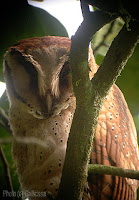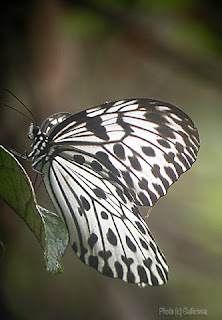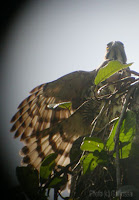“… persons who come into possession, or have opportunities for observing the habits, of this rare owl, are urged to do all they can to note and record permanently every detail about it"
- G.M. Henry, 1955 in A Guide to the Birds of Ceylon
Ranjith Premasiri, a sharp-eyed local guide from Sinharaja, rang me on 18 Jan., 2007 at around 10.15 a.m. He gave me a ‘breaking news’ that a day roost of a Sri Lanka Bay Owl
Phodilus assimilis had been discovered by him. That was while accompanying a couple of British bird watchers and their local bird tour guide, the day before. And with the same breath, he added that, it was re-spotted in a different tree today.

According to him, when it was first seen it had been out in the open on a tree sapling at almost eye level beside a track leading to a few village houses. The guides apparently had misidentified it as Serendib Scops Owl! Lester Perera, a local birder, (and Vajira Wijeygoonawardene) who had been at Sinharaja at that time, had heard the news and visited the site to find a Sri Lanka Bay Owl instead!
I thanked the two informants and told them that I am on my way. I rang my local tuktuk driver, Sarath, to come to pick me up, ready for a long trip. We were on the road by 10.30 a.m. and after buying enough social lubricants to quench the thirst on the way and to celebrate in the evening, we arrived at Sinharaja by 2.15 p.m., after way too many unscheduled stops en route.
I met Ranjith and his colleague Tilak who took me to the site. Soon, I was looking at my first Sri Lanka Bay Owl! Just amazing! It was about 5 metres above the ground, and about 12 m away from the track. I quickly mounted my digi-scoping gear and took some record shots.
It was facing its back towards the road and every now and then looked over the shoulders. It would also go into a rocking motion—slowly moving its body sideways, presumably to ease of the strain on the legs after perching motionless for sometime. Unfortunately, it was terribly overcast by the time I arrived at the scene, and I could only take a few record shots, before the rain started to absolutely belt down with rain.
When the rains eased off after an hour or so it began to get terribly misty. That hampered further photography. Anyway, before all this. I had said good-bye to Sarath who left unconvinced of my explanations as to why I took all this trouble over a single bird.

About an hour aftre, more birders flocked to the site—thanks to Ranjith the informant. These included Uditha Hettige and Chinthaka de Silva and Palitha Anthony. As for me, it turned out to be lifer for them too! A much sought after one at that. I also met Lester and Vajira who correctly identified it a day before.
Light kept on deteriorating. Undaunted, I lingered on to see it leaving the roost. I was joined by Thandula Jayaratne, arguably the best birder among the local guides in Sinharaja, who only learnt the news of this mega bird from me! As the dusk approached all the visitors left, leaving only me and Thandula at the site. I had it focused in my scope to observe it in the deteriorating light.
As the dusk was approaching it was moving slightly along the perch and making rocking motions more often. It was also seen stretching its wings several times indicating it was ready to leave the roost pretty soon. After a while, the calls of Sri Lanka Frogmouth filled the air announcing the dusk by around 6.20 p.m. However, the owl appeared in no hurry to leave its roost any time soon. I waited.
I observed it. I checked the time. I noted that it left its perch at 7.12 p.m.—when dusk has given way to night completely.
It was gone. But, we remained at the site hoping to take a sound recording of it. No luck. As we were about to call it a day, a rustle in a nearby Jak tree caught both our attention. I flashed my torch. And there it was a Sri Lanka Bay Owl, again. This being the nightime, the bird was clearly at its element. We couldn’t be sure whether it was the same bird or a different one. It was glancing down very eagerly and seemed to be looking for its first meal of the day and seemed oblivious to our presence. It also flew about in different branches and after doing so walked a bit along them looking down all the time. Using this opportunity, I tried my first every night time digi-scoping shots taken of any bird, which turned out better than I expected.
Close to the original site of roost, and the tree it was observed during the night time was a dead Fish Tail Palm tree
Caryota urens with an hollow top. Sri Lanka Bay Owl is known to nest it tree holes. And I suspected that this Bay Owl may be nesting at this site. However, we couldn’t see it reaching this dead tree when we were there. Finally at around 7.55 a.m. it flew in the direction of the river, prompting us to call it a day.
Dinner, celebrations and overnight stay in Thandula’s residence.
Early next morning, Thandula and I reached the site. Despite searching the nearby trees we could not locate the bird. Soon, the birders and photographers who were here yesterday; plus more who had come from Colombo this morning were at the site. They included Namal Kamlgoda and Gihan Rajapakse, both equipped with the latest digital cameras and monster telephoto lenses.
We were all assembled near the Jak fruit tree in which the owl was seen by Thandula and me last night. Apparently, Namal has a conference to attend in Kandalama Hotel, in Dambulla (close to north central Sri Lanka) this afternoon and had come here (south western interior, Sri Lanka) 'on the way'. And Namal learnt that one of birders had arrived here yesterday by a tuktuk. We were swapping such stories and showing off each others pictures of this high profile rarity. The newly arrived were making no real effort in looking for it. Perhaps the photographers in them were overawed by the sheer number of birders present and thought somebody will find it. The ones who had seen it already were more happy to brag about the sightings yesterday and engage in small talk. Perhaps given its rarity, it was too much to expect for a Sri Lanka Bay owl to be sighted for three straight days.
Soon it was time for Namal and Gihan to hit the road for their conference. The rest of us also went in our own ways. Guided by the cues of the cacophony of bird calls as the sun broke out, I went on a walk down the same track looking for other birds. A consolation came, when I saw the Chestnut-backed Owlet below. It was quite photogenic.

One of those pics appeared in an article in Oriental Bird Club’s BirdingAsia, Number 7 (June 2007) titled
Identification of Asian Glaucidium owlets done by Mathias Ritschard and Manuel Schweizer.

Ambling back to the Bay Owl site, I noticed few birders and Thandula were still lingering around the same place where I left them. Knowing his antics, Thandula’s smirk was a give away. I knew he had found the Owl. The question was where? The answer came after a teasing pause. Jesus, Mary and Joseph!, it was in the Jak Fruit Tree!!—the very spot we were all standing and doing everything but finding it!
To be fair by all of us, it was visible only from a narrow angle looking from the main trail & and the spot was well concealed by foliage. Anyway that's why we missed it!! This Jak Tree, was bordering a tea garden in one side and and a separate track that branches off the main track on the other. Moving around its perch, we could find about 3 good angles in which the bird was showing well.
We observed it in the same night (19 Jan) too and observed that the bird left the roost when it was completely dark at around 7.20 p.m. Thandula and I had the company a few more birders at the site. We observed the bird to be flying between the Jak fruit tree and another tree that was close by, middle of which was the dead Fish Tail Palm that I first suspected to be the nest tree. After observing it for a while, we all left the site without stressing the bird too much. Later on, Uditha had observed a Bay Owl approaching the top of the dead Palm making a squeaky note with a second bird responding in a similar manner from inside the hole and continuing to do so. He had also seen this bird that approached the tree hole entering it. So I was right; they were nesting!
Post Script: Uditha, Palitha and Deepal Warakagoda, the Serendib Scops Owl discoverer met with a dangerous road accident in February, while driving to Sinharaja to observe these nesting Bay Owls. This had happened when their vehicle was skidded several metres off the road into a ditch. It had happened when trying to avoid a head-on collision with a truck coming at dangerous speed. Two persons suffered considerable injuries. However, considering the circumstances, it was a lucky escape as it could have been a lot worse. This unfortunate incident prevented further monitoring of the nest by them. I stopped my night time observations after 18 & 19 Jan., as the local forest rangers weren’t too happy in birders trying to learn more about the ecology of a rare forest bird.



































